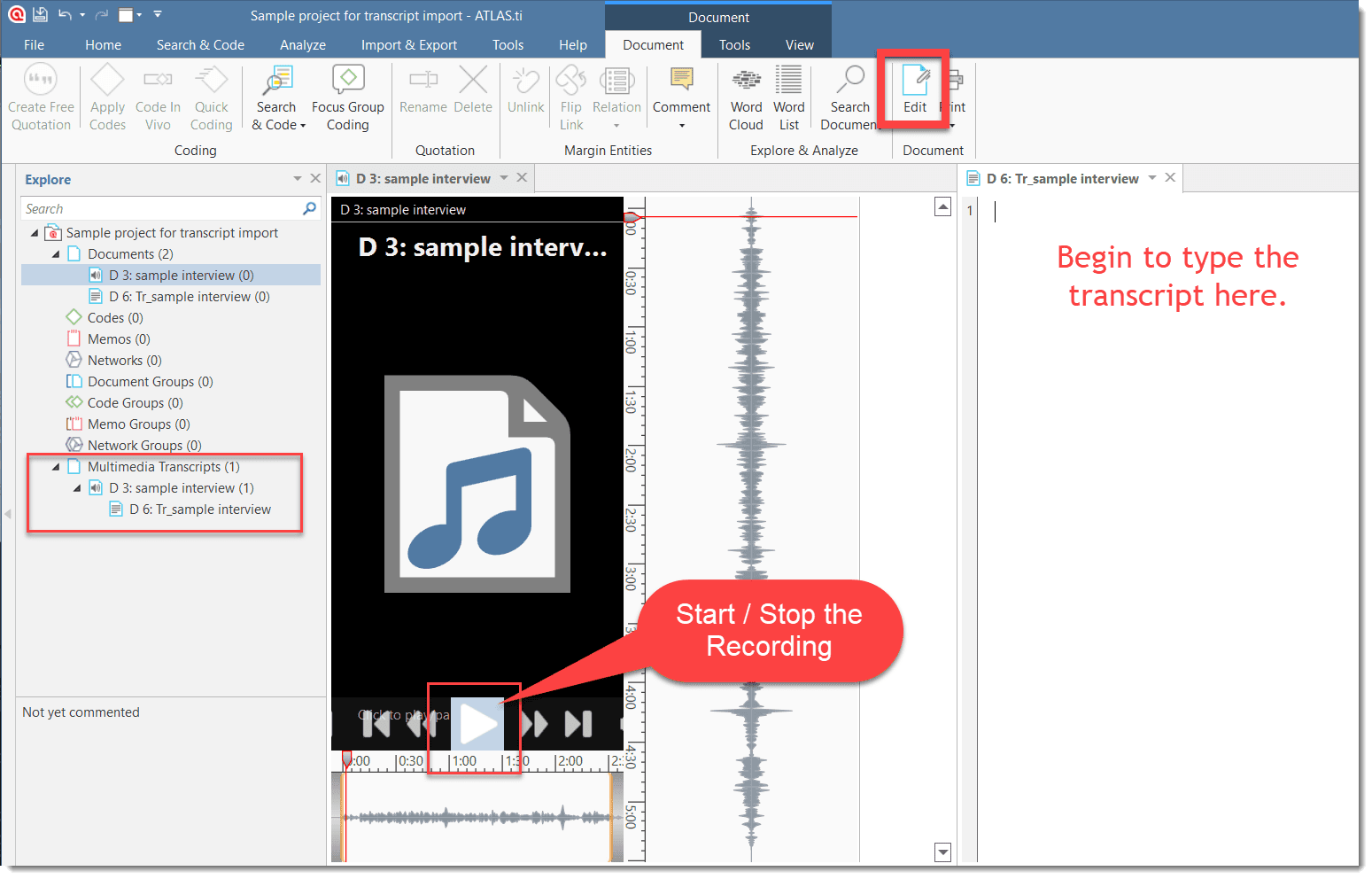- What is Interview Analysis?
- Advantages of Interviews in Research
- Disadvantages of Interviews in Research
- Ethical Considerations in Interviews
- Preparing a Research Interview
- Recruitment & Sampling for Research Interviews
- Interview Design
- How to Formulate Interview Questions
- Rapport in Interviews
- Social Desirability Bias
- Interviewer Effect
- Types of Research Interviews
- Face-to-Face Interviews
- Focus Group Interviews
- Email Interviews
- Telephone Interviews
- Stimulated Recall Interviews
- Interviews vs. Surveys
- Interviews vs Questionnaires
- Interviews and Interrogations
- How to Transcribe Interviews?
- Verbatim Transcription
- Clean Interview Transcriptions
- Manual Interview Transcription
- Automated Interview Transcription
- How to Annotate Research Interviews?
- Formatting and Anonymizing Interviews
- Analyzing Interviews
- Coding Interviews
- Reporting & Presenting Interview Findings
- How to cite "The Guide to Interview Analysis"
Verbatim Transcription
Verbatim transcription is the process of converting spoken language into written text exactly as it was spoken, without making any changes or omissions. This means capturing every word, pause, filler expression (like "um," "uh"), stutters, repetitions, and even non-verbal sounds such as laughter, sighs, or coughs if required. The goal is to create a written record that mirrors the original audio precisely, preserving the speaker's exact words and speech patterns.

Introduction
From the subtle inflections in a voice to the hesitations and filler words that pepper our conversations, every element of spoken language can contribute to a deeper understanding of human behavior, thought processes, and cultural dynamics. This is particularly true in qualitative research, where the richness of data lies not just in what is said, but how it is said. Verbatim transcription emerges as an indispensable tool in this context, serving as a bridge between the ephemeral nature of speech and the permanence of the written word.
A verbatim transcript serves as a reliable written record of the conversation. It makes sure that nothing is lost from the original audio file. This is crucial for verifying data, conducting thorough analyses, and supporting findings with direct quotes.
By transcribing the exact spoken word, researchers minimize the risk of misinterpretation. Verbatim transcriptions preserve the speaker's intent, providing an accurate foundation for coding and thematic analysis.
Verbatim transcription is also used in various scenarios where an accurate and detailed record of spoken words is essential. In court hearings, depositions, and witness testimonies, verbatim transcription provides a precise and accurate record of all exchanges. Every word and pause can hold significant weight in legal contexts. Researchers conducting interviews or focus groups rely on verbatim transcripts to analyze participants' responses thoroughly, capturing nuances that might be lost in summarized notes.
For important meetings where decisions and action items are discussed, verbatim transcription ensures that all details are accurately documented for future reference. Journalists transcribe interviews verbatim to maintain the integrity of their sources' statements, avoiding misrepresentation. Verbatim transcription is crucial for creating captions and transcripts that make audio and video content accessible to individuals with hearing impairments.
Benefits of verbatim transcription
By transcribing the exact spoken word, verbatim transcription minimizes the risk of misinterpretation. It preserves the speaker's intent and provides an accurate foundation for coding and thematic analysis, which is vital in qualitative research. In the legal industry, verbatim transcripts serve as official records that can be used as evidence in court. They capture every detail of conversations and exchanges, ensuring that nothing is left to ambiguity.
Verbatim transcription makes audio and video content accessible to a wider audience, including those with hearing impairments. By providing detailed transcripts and captions, it ensures inclusivity and compliance with accessibility standards. By capturing every word spoken in meetings, verbatim transcription helps improve communication and collaboration among team members. It provides a clear record of discussions, decisions, and action items, facilitating better follow-through and accountability. Verbatim transcription captures non-verbal cues like laughter, sighs, and pauses, which can provide valuable context and insight into the speaker's emotions and intentions.
Verbatim transcriptions in ATLAS.ti
ATLAS.ti Desktop and ATLAS.ti Web offer robust support for working with verbatim transcriptions, making it an ideal tool for qualitative researchers who handle large amounts of interviews, focus group, or other textual data. One of the core strengths of ATLAS.ti desktop is its ability to easily import transcripts in various formats, such as txt, rtf, doc, docx, srt, and vtt, allowing researchers to integrate their raw data into the platform seamlessly. Once imported, transcripts with timestamps can be automatically synched with the original recording and researchers can still edit their transcripts in ATLAS.ti, making it comfortable to check the transcript against the raw data or seamlessly move between the raw data and the transcript
A key feature that ATLAS.ti provides is its coding functionality, which allows researchers to systematically analyze transcriptions. Through coding, users can identify themes, patterns, and significant segments in the text. This process is facilitated by Conversational AI or the Intentional AI tool, which facilitates the coding process by suggesting codes based on the content of the data. This is especially helpful when handling large volumes of transcripts, as the AI can quickly apply codes, which can then be reviewed, refined, or combined with manual insights.
In addition to coding, ATLAS.ti enables the creation of quotations, which are selected excerpts from the transcripts that represent key points or ideas. Quotations are especially useful in qualitative analysis for keeping track of significant pieces of text that may later be used for reporting or drawing conclusions. Researchers can also apply memos to their transcripts, adding notes and reflections about specific segments of the text. Memos act as a personal research journal, helping document initial thoughts, ideas, or the interpretation of data as the analysis progresses.

ATLAS.ti also supports inter-coder agreement, a crucial tool when multiple researchers are working on the same set of transcriptions. This feature allows the team to assess how consistently different coders are applying the same codes to the text. It enhances the reliability of the analysis, particularly in collaborative research projects. Tools such as Krippendorff’s alpha and the Holsti Index are built into ATLAS.ti to measure this agreement, ensuring rigor and validity in the coding process.
Finally, ATLAS.ti’s reporting features make it easy to extract insights from the coded transcriptions. Researchers can generate detailed reports that compile all coded segments, organize findings by theme, or even visualize patterns through word clouds and code co-occurrence tables. These outputs can be exported into formats like Word or Excel, making it simple to integrate into broader research reports, presentations, or publications. This comprehensive support for transcription analysis makes ATLAS.ti a powerful tool for qualitative researchers handling textual data.
Best practices for verbatim transcription
To achieve high-quality verbatim transcripts, clear recordings are essential for accurate transcription. It is important to use reliable microphones and recording devices to minimize background noise and ensure that all speakers are heard distinctly. Transcribing audio files in a quiet space is essential to maintain focus and reduce the likelihood of errors. This helps in catching subtle details like soft-spoken words or faint non-verbal sounds.
Researchers can employ tools like foot pedals, specialized transcription software, and text expanders to control playback and enhance typing efficiency. These tools can significantly speed up the transcription process. Understanding the context, subject matter, and any industry-specific terminology can help in accurately transcribing technical terms and complex discussions. After transcribing, review the transcript thoroughly to ensure accuracy. Pay attention to homophones, grammatical errors, and punctuation, which can alter the meaning of the text.
When dealing with sensitive information, ensure that all data handling complies with privacy regulations and confidentiality agreements.
Examples of verbatim transcription uses
Qualitative research
Verbatim transcription is indispensable in qualitative research because it captures every detail of participants' spoken words, including pauses, fillers, and emotional expressions, which are crucial for deep analysis. For example, in a study exploring the experiences of first-time mothers, researchers conducted in-depth interviews to understand their emotional journeys. By transcribing these interviews verbatim, they preserved the authenticity of each mother's narrative, including moments of hesitation, laughter, or tears. This meticulous transcription allowed the researchers to identify subtle themes and patterns—such as underlying anxieties or sources of joy—that might have been overlooked with a non-verbatim approach. The rich, detailed data provided insights that led to more empathetic healthcare recommendations and support programs for new mothers.
Accessibility services
Verbatim transcription plays a vital role in making content accessible to everyone. For individuals with hearing impairments, detailed transcripts ensure they don't miss any part of a conversation or audio content. Including non-verbal cues captures emotional nuances, providing a richer understanding of the material. Transcripts are used to create accurate captions and subtitles for videos, making them accessible to a wider audience. In educational contexts, transcribing lectures, podcasts, and seminars allows for better accessibility and aids in learning, ensuring that educational resources are inclusive.
Corporate meetings
In the corporate environment, verbatim transcription enhances communication and documentation. By capturing every word spoken during meetings, it ensures that discussions, decisions, and action items are thoroughly documented, leading to comprehensive meeting minutes. This level of detail helps team members who were absent stay informed and contribute effectively to projects. Transcripts from training sessions can be repurposed as reference materials or onboarding documents, enriching the company's training resources. Additionally, transcribing conferences and corporate events allows organizations to create detailed reports, summaries, or promotional content, thereby enhancing event documentation and extending the value of these gatherings.
Legal industry
In legal settings, verbatim transcription is indispensable. Court proceedings rely on transcripts that provide an exact record of everything said during hearings, which is crucial for appeals and legal reviews. During depositions and witness testimonies, capturing every word and non-verbal cue ensures that testimonies are accurately represented and can be scrutinized for inconsistencies. In insurance investigations, verbatim transcription helps detect false statements and analyze speech patterns, aiding in fraud detection. Such transcripts can also be submitted as evidence in court or when presenting a case to law enforcement, underscoring their vital role in the legal process.

Conclusion
Verbatim transcription is a powerful tool that bridges the gap between spoken language and written text, preserving the authenticity and richness of human communication. Whether in legal proceedings, qualitative research, corporate meetings, or accessibility services, the ability to capture the exact spoken word is invaluable.
By understanding the different types of verbatim transcription and implementing best practices, professionals across various industries can ensure that their transcripts are accurate, reliable, and serve their intended purpose effectively. The meticulous process of verbatim transcription not only enhances the integrity of the data but also unlocks deeper insights that might otherwise remain hidden.
As technology continues to evolve, the tools and methods for transcription will undoubtedly advance. However, the fundamental importance of capturing the nuances of speech will remain constant. Embracing verbatim transcription is embracing a commitment to detail, authenticity, and a deeper understanding of the human experience.




